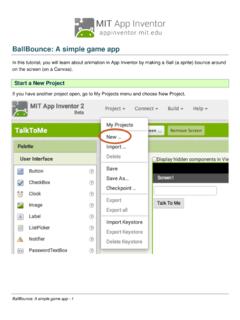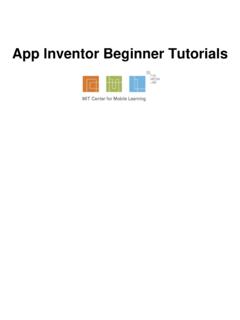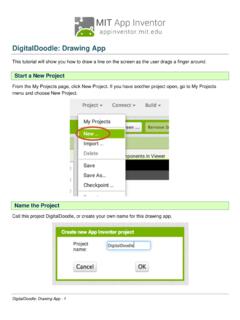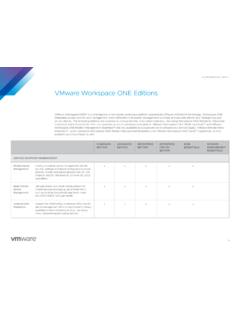Transcription of App Inventor Beginner Tutorials - App Inventor for Android
1 App Inventor Beginner Tutorials 1 Four Simple Tutorials for Getting Started with App Inventor TalkToMe: Your first App Inventor app 4. TalkToMe Part 2: Shaking and User Input 23. BallBounce: A simple game app 33. DigitalDoodle: Drawing App 47. Four Simple Tutorials for Getting Started with App Inventor App Inventor Beginner Tutorials - 3. TalkToMe: Your first App Inventor app This step-by-step picture tutorial will guide you through making a talking app. To get started, go to App Inventor on the web. Go directly to , or click the orange "Create" button from the App Inventor website. App Inventor Beginner Tutorials - 4. Log in to App Inventor with a gmail (or google) user name and password. Use an existing gmail account or school-based google account to log in to To set up a brand new gmail account, go to App Inventor Beginner Tutorials - 5. Click "Continue" to dismiss the splash screen. App Inventor Beginner Tutorials - 6. Start a new project. Name the project "TalkToMe" (no spaces!)
2 Type in the project name (underscores are allowed, spaces are not) and click OK. App Inventor Beginner Tutorials - 7. You are now in the Designer, where you lay out the "user interface" of your app. The Design Window, or simply "Designer" is where you lay out the look and feel of your app, and specify what functionalities it should have. You choose things for the user interface things like Buttons, Images, and Text boxes, and functionalities like Text-to-Speech, Sensors, and GPS. Add a Button Our project needs a button. Click and hold on the word "Button" in the palette. Drag your mouse over to the Viewer. Drop the button and a new button will appear on the Viewer. App Inventor Beginner Tutorials - 8. Connect App Inventor to your phone for live testing One of the neatest things about App Inventor is that you can see and test your app while you're building it, on a connected device. If you have an Android phone or tablet, follow the steps below. If you do not have a device, then follow the instructions for setting up the on-screen emulator (opens a new page) and then come back to this tutorial once you've gotten the emulator connected to App Inventor .
3 App Inventor Beginner Tutorials - 9. Get the MIT AI2 Companion from the Play Store and install it on your phone or tablet. The preferred method for getting the AI2 Companion App is to download the app from the Play Store by searching for "MIT AI2 Companion". App Inventor Beginner Tutorials - 10. To download the AI2 Companion App to your device directly (SKIP THIS STEP IF. YOU already got the app from Play Store). If for some reason you can not connect to the Google Play store, you can download the AI2 Companion as described here. First, you will need to go into your phone's settings (#1), choose "Security", then scroll down to allow "Unknown Sources", which allows apps that are not from the Play Store to be installed on the phone. Second, do one of the following: A) Scan the QR code above (#2). or B) Click the "Need help " link and you'll be taken to the download page. From there you can download the file to your computer and then move it over to your device to install it.
4 App Inventor Beginner Tutorials - 11. Start the AICompanion on your device On your phone or tablet, click the icon for the MIT AI Companion to start the app. NOTE: Your phone and computer must both be on the same wireless network. Make sure your phone's wifi is on and that you are connected to the local wireless network. If you can not connect over wifi, go to the Setup Instructions on the App Inventor Website to find out how to connect with a USB cable. App Inventor Beginner Tutorials - 12. Get the Connection Code from App Inventor and scan or type it into your Companion app On the Connect menu, choose "AI Companion". You can connect by: 1 - Scanning the QR code by clicking "Scan QR code" (#1). or 2 - Typing the code into the text window and click "Connect with code" (#2). App Inventor Beginner Tutorials - 13. See your app on the connected device You will know that your connection is successful when you see your app on the connected device. So far our app only has a button, so that is what you will see.
5 As you add more to the project, you will see your app change on your phone. App Inventor Beginner Tutorials - 14. Change the Text on the Button On the properties pane, change the text for the Button. Select the text "Text for Button 1", delete it and type in "Talk To Me". Notice that the text on your app's button changes right away. App Inventor Beginner Tutorials - 15. Add a Text-to-Speech component to your app Go to the Media drawer and drag out a TextToSpeech component. Drop it onto the Viewer. Notice that it drops down under "Non-visible components" because it is not something that will show up on the app's user interface. It's more like a tool that is available to the app. App Inventor Beginner Tutorials - 16. Switch over to the Blocks Editor It's time to tell your app what to do! Click "Blocks" to move over to the Blocks Editor. Think of the Designer and Blocks buttons like tabs -- you use them to move back and forth between the two areas of App Inventor . App Inventor Beginner Tutorials - 17.
6 The Blocks Editor The Blocks Editor is where you program the behavior of your app. There are Built-in blocks that handle things like math, logic, and text. Below that are the blocks that go with each of the components in your app. In order to get the blocks for a certain component to show up in the Blocks Editor, you first have to add that component to your app through the Designer. App Inventor Beginner Tutorials - 18. Make a button click event Click on the Button1 drawer. Click and hold the when do block. Drag it over to the workspace and drop it there. This is the block that will handle what happens when the button on your app is clicked. It is called an "Event Handler". App Inventor Beginner Tutorials - 19. Program the TextToSpeech action Click on the TextToSpeech drawer. Click and hold the call block. Drag it over to the workspace and drop it there. This is the block that will make the phone speak. Because it is inside the , it will run when the button on your app is clicked.
7 App Inventor Beginner Tutorials - 20. Fill in the message socket on Block Almost done! Now you just need to tell the block what to say. To do that, click on the Text drawer, drag out a text block and plug it into the socket labeled "message". Specify what the app should say when the button is clicked Click on the text block and type in "Congratulations! You've made your first app." (Feel free to use any phrase you like, this is just a suggestion.). App Inventor Beginner Tutorials - 21. Now test it out! Go to your connected device and click the button. Make sure your volume is up! You should hear the phone speak the phrase out loud. (This works even with the emulator.). Great job! Now move on to TalkToMe Part 2 to make the app respond to shaking and to let users put in whatever phrase they want. App Inventor Beginner Tutorials - 22. TalkToMe Part 2: Shaking and User Input This tutorial shows you how to extend the basic TalkToMe app so that it responds to shaking, and so that the user can make the phone say any phrase s/he types in.
8 Go to App Inventor on the web and log in. Go to and click "Create" or log in directly at App Inventor Beginner Tutorials - 23. Open the "TalkToMe" project that you worked on in the last tutorial. App Inventor will always open the last project you worked on, so you may automatically be taken into your TalkToMe app. Go to the Designer Tab Your project may open in the Designer. If it does not, click "Designer" in the upper right. App Inventor Beginner Tutorials - 24. Add an Accelerometer Sensor In the Sensors drawer, drag out an AccelerometerSensor component and drop it onto the Viewer. (It's a non-visible component, so it drops to the bottom of the screen.) NOTE: emulator users should skip this part and proceed to the next section of this tutorial called "Say Anything". (The emulator can not respond to shaking!). App Inventor Beginner Tutorials - 25. Go to the Blocks Editor Click "Blocks" to program the new Accelerometer Sensor that you just added. Program the Accelerometer Shaking event Click the AccelerometerSensor1 drawer to see its blocks.
9 Drag out the when do block and drop it on the workspace . App Inventor Beginner Tutorials - 26. What do we want the app to do when the accelerometer detects shaking? Copy and paste the blocks that are currently inside the when event handler. You can select the purple block, then hit the key combination on your computer to copy and then to paste. You'll have a second set of blocks to put inside the when block. (Alternatively, you can drag out a new call block from the TextToSpeech drawer, and a new pink text block from the Text drawer.). Change the phrase that is spoken when the phone is shaking. Type in something funny for when the phone responds to shaking. App Inventor Beginner Tutorials - 27. Test it out! You can now shake your phone and it should respond by saying "Stop shaking me!" (or whatever phrase you put in.). Say Anything Is your phone talking to you? Cool! Now let's program the button click so that it causes the phone to speak whatever phrase the user put into the text box.
10 Go back to the Designer. App Inventor Beginner Tutorials - 28. Add a Text Box to your user interface. From the User Interface drawer, drag out a TextBox and put it above the Button that is already on the screen. Back to the Blocks Editor! App Inventor Beginner Tutorials - 29. Get the text that is typed into the TextBox. Get the text property of the TextBox1. The green blocks in the TextBox1 drawer are the "getters" and "setters" for the TextBox1 component. You want your app to speak out loud whatever is currently in the TextBox1 Text property ( whatever is typed into the text box). Drag out the getter block. App Inventor Beginner Tutorials - 30. Set the Button Click event to speak the text that is in the Text Box. Pull out the " " text box and plug in the block. You can throw the pink text block away by dragging it to the trash in the lower right corner of the workspace . Test your app! Now your app has two behaviors: When the button is clicked, it will speak out loud whatever words are currently in the Text Box on the screen.








